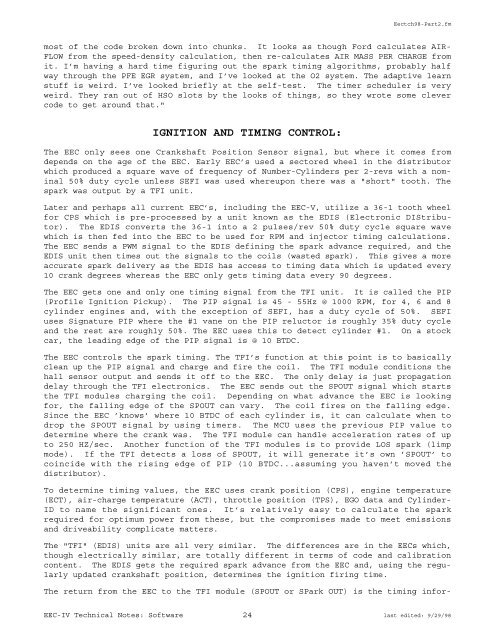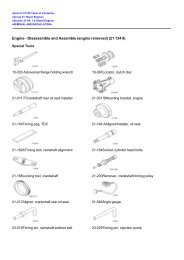TECHNICAL NOTES ON THE EEC-IV MCU - Auto diagnostics
TECHNICAL NOTES ON THE EEC-IV MCU - Auto diagnostics
TECHNICAL NOTES ON THE EEC-IV MCU - Auto diagnostics
You also want an ePaper? Increase the reach of your titles
YUMPU automatically turns print PDFs into web optimized ePapers that Google loves.
Eectch98-Part2.fm<br />
most of the code broken down into chunks. It looks as though Ford calculates AIR-<br />
FLOW from the speed-density calculation, then re-calculates AIR MASS PER CHARGE from<br />
it. I’m having a hard time figuring out the spark timing algorithms, probably half<br />
way through the PFE EGR system, and I’ve looked at the O2 system. The adaptive learn<br />
stuff is weird. I’ve looked briefly at the self-test. The timer scheduler is very<br />
weird. They ran out of HSO slots by the looks of things, so they wrote some clever<br />
code to get around that."<br />
IGNITI<strong>ON</strong> AND TIMING C<strong>ON</strong>TROL:<br />
The <strong>EEC</strong> only sees one Crankshaft Position Sensor signal, but where it comes from<br />
depends on the age of the <strong>EEC</strong>. Early <strong>EEC</strong>’s used a sectored wheel in the distributor<br />
which produced a square wave of frequency of Number-Cylinders per 2-revs with a nominal<br />
50% duty cycle unless SEFI was used whereupon there was a "short" tooth. The<br />
spark was output by a TFI unit.<br />
Later and perhaps all current <strong>EEC</strong>’s, including the <strong>EEC</strong>-V, utilize a 36-1 tooth wheel<br />
for CPS which is pre-processed by a unit known as the EDIS (Electronic DIStributor).<br />
The EDIS converts the 36-1 into a 2 pulses/rev 50% duty cycle square wave<br />
which is then fed into the <strong>EEC</strong> to be used for RPM and injector timing calculations.<br />
The <strong>EEC</strong> sends a PWM signal to the EDIS defining the spark advance required, and the<br />
EDIS unit then times out the signals to the coils (wasted spark). This gives a more<br />
accurate spark delivery as the EDIS has access to timing data which is updated every<br />
10 crank degrees whereas the <strong>EEC</strong> only gets timing data every 90 degrees.<br />
The <strong>EEC</strong> gets one and only one timing signal from the TFI unit. It is called the PIP<br />
(Profile Ignition Pickup). The PIP signal is 45 - 55Hz @ 1000 RPM, for 4, 6 and 8<br />
cylinder engines and, with the exception of SEFI, has a duty cycle of 50%. SEFI<br />
uses Signature PIP where the #1 vane on the PIP reluctor is roughly 35% duty cycle<br />
and the rest are roughly 50%. The <strong>EEC</strong> uses this to detect cylinder #1. On a stock<br />
car, the leading edge of the PIP signal is @ 10 BTDC.<br />
The <strong>EEC</strong> controls the spark timing. The TFI’s function at this point is to basically<br />
clean up the PIP signal and charge and fire the coil. The TFI module conditions the<br />
hall sensor output and sends it off to the <strong>EEC</strong>. The only delay is just propagation<br />
delay through the TFI electronics. The <strong>EEC</strong> sends out the SPOUT signal which starts<br />
the TFI modules charging the coil. Depending on what advance the <strong>EEC</strong> is looking<br />
for, the falling edge of the SPOUT can vary. The coil fires on the falling edge.<br />
Since the <strong>EEC</strong> ’knows’ where 10 BTDC of each cylinder is, it can calculate when to<br />
drop the SPOUT signal by using timers. The <strong>MCU</strong> uses the previous PIP value to<br />
determine where the crank was. The TFI module can handle acceleration rates of up<br />
to 250 HZ/sec. Another function of the TFI modules is to provide LOS spark (limp<br />
mode). If the TFI detects a loss of SPOUT, it will generate it’s own ’SPOUT’ to<br />
coincide with the rising edge of PIP (10 BTDC...assuming you haven’t moved the<br />
distributor).<br />
To determine timing values, the <strong>EEC</strong> uses crank position (CPS), engine temperature<br />
(ECT), air-charge temperature (ACT), throttle position (TPS), EGO data and Cylinder-<br />
ID to name the significant ones. It’s relatively easy to calculate the spark<br />
required for optimum power from these, but the compromises made to meet emissions<br />
and driveability complicate matters.<br />
The "TFI" (EDIS) units are all very similar. The differences are in the <strong>EEC</strong>s which,<br />
though electrically similar, are totally different in terms of code and calibration<br />
content. The EDIS gets the required spark advance from the <strong>EEC</strong> and, using the regularly<br />
updated crankshaft position, determines the ignition firing time.<br />
The return from the <strong>EEC</strong> to the TFI module (SPOUT or SPark OUT) is the timing infor-<br />
<strong>EEC</strong>-<strong>IV</strong> Technical Notes: Software 24 last edited: 9/29/98




